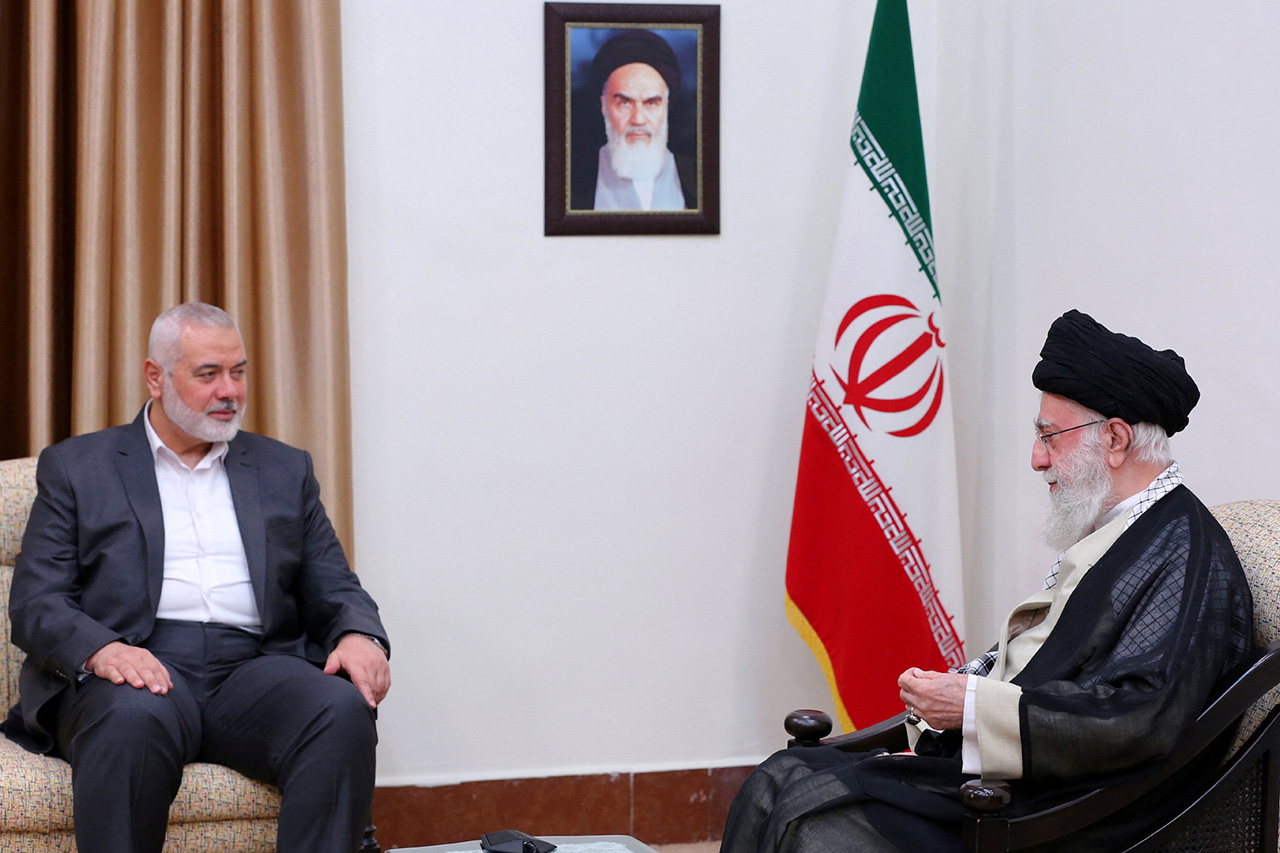Israel-Hamas War Catches Palestinians in a Political Clinch
The 7 October Hamas attack on Israel and the Israeli military’s reaction have deeply destabilised the political situation in the Palestinian territories. Despite the surprise attack’s tactical success, the Hamas leadership is in danger of losing power in the Gaza Strip if Israel dismantles its structures in a ground operation. Israel’s war with Hamas may benefit the Palestinian Authority (PA) Fatah leadership politically, but it remains too weak to effectively influence the current situation.
 AA/ABACA / Abaca Press / Forum
AA/ABACA / Abaca Press / Forum
The Palestinian Territories before 7 October
Since the last major Israeli-Palestinian confrontation in May 2021, the situation in the Hamas-ruled and Israeli-Egyptian blockaded Gaza Strip and the Fatah-controlled West Bank has developed in two dimensions. Hamas reduced terrorism against Israel from the Gaza Strip while at the same time, according to Israel, increasing it in the West Bank. The most severe clashes in the Strip involved other terrorist groups operating there (such as the Palestinian Islamic Jihad in August 2022). This period of relative calm after 2021 was accompanied by an intensification of Israeli and foreign partners’ actions calculated to consolidate this trend through economic means. Israel eased restrictions on trade in goods, expanded the fishing zone, and increased the number of work permits in Israel for Gaza residents. The Strip’s energy needs were to be included in plans regarding Palestinian gas deposits in adjacent territorial waters. On the political level, Hamas returned to reconciliation talks with Fatah, although a July summit of the two parties in Egypt did not result in an agreement. Hamas also agreed—just days before the attack on Israel—to hold local elections in the Gaza Strip. These actions, however, did little to improve the livelihood of Gaza’s residents (about 2.3 million), who were in extremely difficult conditions before the latest war (e.g., official unemployment was as high as 46%). Frustration with this situation was reflected in protests against the Hamas authorities in July.
The West Bank and its residents (about 3 million) also operated under difficult political conditions, primarily related to the weakness of the Fatah authorities, widely regarded by Palestinians as inept and corrupt. This led to a reduction in external financial aid from Arab states and growing public sympathy for Hamas, especially after the cancellation of parliamentary elections in 2021. A sign of the PA’s weakness was the de facto loss of control over the security situation in Jenin and Nablus where new armed groups gained control. The result was the deployment of a large number of Israeli forces and military operations conducted with a high number of casualties, both fighters and civilians on the Palestinian side (in 2022 and 2023, the highest number since the Second Intifada). The public mood and radicalisation were further aggravated by the actions of Jewish radicals (attacks on Palestinians, arson and destruction of property), which highly escalated after Benjamin Netanyahu’s return to power. The situation in Jerusalem has also been in constant tension, primarily concerning the Temple Mount and Al-Aqsa Mosque.
In recent months, the PA leadership undertook new political actions. President Mahmoud Abbas reshuffled some of its apparatus (e.g., local governors), returned to talks with Hamas, and announced a Fatah Congress for December. However, these actions were not so much a reaction to the PA’s problems as they were a response to tensions within the Fatah leadership over the still unclear scenario of the expected power succession. Palestinian public opinion polls reflect a deficit of trust in Palestinian institutions, the regime of Israeli occupation, and the lack of prospects for improvement. In a survey conducted in September, about two-thirds of Palestinians surveyed considered conditions before the current conflict to be worse than those preceding the Oslo Accords in the 1990s and support for withdrawing from the agreement. Nearly 80% would like Abbas to resign, while 70% also rated the Hamas authorities as corrupt. 58% favoured armed struggle or a new intifada as a means of changing political realities (up 10 percentage points from 2022).
Hamas’ and Fatah’s Calculations
After the 7 October attack by Hamas, decision-making on that side has been concentrated primarily in the hands of the Gaza military command (Al-Qassam Brigades), although political representation residing in Qatar still plays an important role. In the short term, the Hamas leadership is counting primarily on the shock effect (caused by the atrocities committed), Israeli fatigue, and international pressure for a ceasefire. The primary bargaining chip is the hostages kidnapped in the attack (about 224 confirmed, including foreigners and Israelis with dual citizenship). Their presence in Gaza reinforces external pressure on the Israeli government to press for their release and on the Israeli military to push back in time or limit the scope of a ground operation. Hamas hopes that a prolonged mobilisation will prove too difficult for Israel to sustain and that the Netanyahu government, fearing entanglement in a protracted conflict and high losses, will not opt for a full-scale operation. The long-term goal of Hamas is to force the release of Palestinian prisoners—around 6,000, along with new ones arrested after 7 October—as part of an exchange and to maintain control of the Gaza Strip. Hamas has been unsuccessful in stirring up anti-Israel sentiment among Israel’s Arab residents but is causing fighting to spill over into the West Bank and Jerusalem (the intended codename of the attack, Operation Al-Aqsa Flood, indicates this was a goal). However, it cannot be ruled out that the protracted conflict, the growing number of casualties on the Palestinian side, and a potential ground invasion will change the situation. An essential element of Hamas’ strategy is information policy regarding the humanitarian crisis in Gaza, intended to increase international pressure on Israel.
For Fatah, the post-7 October situation carries two consequences. On the one hand, in a scenario of a successful Israeli offensive to eradicate Hamas, its main rival could be seriously weakened, allowing Fatah to restore PA control over the Gaza Strip and create the conditions for new political initiatives by taking advantage of the international community’s high level of involvement now. However, the highly unpopular and institutionally weak PA leadership lacks sufficient political power to take advantage of such circumstances. Passivity in the face of increasing Palestinian casualties in Gaza further undermines the credibility of Fatah in the eyes of the Palestinians, which could be exacerbated by Hamas successes, for example, in halting the Israeli offensive or prisoner exchanges. Hence, the PA authorities are reluctant to openly condemn Hamas’ actions out of concern for their own political situation and are therefore focusing on protests against Israeli operations and mobilising world public opinion towards the Palestinians.
Conclusions and Outlook
The concept followed by the Israeli authorities (including the broad coalition government in 2021-2022) up to 7 October was that Hamas would be more interested in stabilising its power in Gaza using external resources (e.g., Qatar). It turned out to be wrong. Hamas’ terrorist operation indicates that violence remains its main instrument in achieving its goals and that the political actions taken in recent months were a smokescreen. The organisation is prepared to take serious risks and accepts losses among Gaza’s population. From the perspective of Israel and the countries of the transatlantic community, the scale and brutality of the 7 October attack permanently deprives Hamas of the possibility of acting as a party to the talks beyond ad hoc negotiations on humanitarian issues in Gaza. Dragging out the current confrontation is in Hamas’ interest, but only in the scenario of the absence or ineffectiveness of an Israeli ground intervention.
How the situation develops will be crucial to the PA succession process. If the scale of civilian casualties in Gaza and the Israeli repression in the West Bank grows, it will only reinforce the radicalisation of Palestinian population and make it more difficult for the PA to continue to lead, up to a scenario of its disintegration or a new intifada.
The current escalation demonstrates the need for political solutions to the Israeli-Palestinian conflict in a way that ends the current iteration of conflict between Israel and Hamas. The chance for a return to talks on a future comprehensive peace process remains contingent on many factors, including the defeat of Hamas, restoration of PA control over Gaza, a change of authorities in Israel, and PA support from Arab states, all of which for now is highly unlikely and remote.





